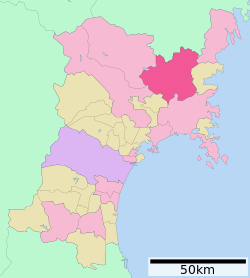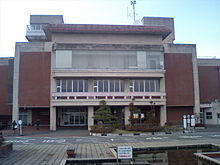| Tome 登米市 | |
|---|---|
| City | |
 Upper: Swans on Hasama River Upper: Swans on Hasama RiverMiddle: Japanese number one hatto Festival. Chacha world Ishikoshi Lower: Korin-ji, Naganuma footopia park | |
 Flag Flag Seal Seal | |
 Location of Tome in Miyagi Prefecture Location of Tome in Miyagi Prefecture | |
 | |
| Coordinates: 38°41′30.6″N 141°11′15.9″E / 38.691833°N 141.187750°E / 38.691833; 141.187750 | |
| Country | Japan |
| Region | Tōhoku |
| Prefecture | Miyagi |
| Town Settled | June 1, 1889 |
| City Settled | April 1, 2005 |
| Government | |
| • Mayor | Morihiro Kumagai (from April 2017) |
| Area | |
| • Total | 536.12 km (207.00 sq mi) |
| Population | |
| • Total | 77,897 |
| • Density | 150/km (380/sq mi) |
| Time zone | UTC+9 (Japan Standard Time) |
| Phone number | 0220-22-2111 |
| Address | 2-6-1 Nakae, Sanuma, Hasama-chō, Tome-shi, Miyagi-ken 987-0595 |
| Climate | Cfa |
| Website | Official website |
| Symbols | |
| Bird | Swan |
| Flower | Sakura |
| Tree | Sugi |

Tome (登米市, Tome-shi) is a city located in Miyagi Prefecture, Japan. As of 30 April 2020, the city had an estimated population of 77,897 and a population density of 150 persons per km in 27,298 households. The total area of the city is 536.12 square kilometres (207.00 sq mi). The area is noted for its rice production.
Geography
Tome is in far northeastern Miyagi Prefecture, bordered by Iwate Prefecture to the north. The Kitakami River flows through the city. The city is approximately 70 kilometers north of the prefectural capital of Sendai.
Neighboring municipalities
Iwate Prefecture
Miyagi Prefecture
Climate
Tome has a humid climate (Köppen climate classification Cfa) characterized by mild summers and cold winters. The average annual temperature in Tome is 11.5 °C (52.7 °F). The average annual rainfall is 1,078.2 mm (42.45 in) with September as the wettest month. The temperatures are highest on average in August, at around 23.8 °C (74.8 °F), and lowest in January, at around −0.1 °C (31.8 °F).
| Climate data for Yoneyama, Tome (1991−2020 normals, extremes 1976−present) | |||||||||||||
|---|---|---|---|---|---|---|---|---|---|---|---|---|---|
| Month | Jan | Feb | Mar | Apr | May | Jun | Jul | Aug | Sep | Oct | Nov | Dec | Year |
| Record high °C (°F) | 15.7 (60.3) |
17.7 (63.9) |
24.4 (75.9) |
30.4 (86.7) |
33.0 (91.4) |
33.8 (92.8) |
36.4 (97.5) |
36.3 (97.3) |
35.0 (95.0) |
30.5 (86.9) |
23.5 (74.3) |
20.3 (68.5) |
36.4 (97.5) |
| Mean daily maximum °C (°F) | 4.6 (40.3) |
5.8 (42.4) |
10.0 (50.0) |
15.9 (60.6) |
20.6 (69.1) |
23.8 (74.8) |
27.1 (80.8) |
28.6 (83.5) |
25.1 (77.2) |
19.8 (67.6) |
13.4 (56.1) |
7.1 (44.8) |
16.8 (62.3) |
| Daily mean °C (°F) | −0.1 (31.8) |
0.6 (33.1) |
4.0 (39.2) |
9.4 (48.9) |
15.1 (59.2) |
19.0 (66.2) |
22.5 (72.5) |
23.8 (74.8) |
20.1 (68.2) |
14.0 (57.2) |
7.6 (45.7) |
2.2 (36.0) |
11.5 (52.7) |
| Mean daily minimum °C (°F) | −4.5 (23.9) |
−4.2 (24.4) |
−1.6 (29.1) |
3.3 (37.9) |
10.4 (50.7) |
15.3 (59.5) |
19.3 (66.7) |
20.4 (68.7) |
15.9 (60.6) |
8.7 (47.7) |
2.2 (36.0) |
−2.1 (28.2) |
6.9 (44.4) |
| Record low °C (°F) | −17.5 (0.5) |
−18.3 (−0.9) |
−13.6 (7.5) |
−7.6 (18.3) |
2.2 (36.0) |
6.8 (44.2) |
11.3 (52.3) |
11.6 (52.9) |
4.6 (40.3) |
−1.9 (28.6) |
−6.1 (21.0) |
−19.5 (−3.1) |
−19.5 (−3.1) |
| Average precipitation mm (inches) | 35.5 (1.40) |
29.1 (1.15) |
69.9 (2.75) |
77.3 (3.04) |
93.6 (3.69) |
111.2 (4.38) |
161.6 (6.36) |
120.1 (4.73) |
150.6 (5.93) |
129.4 (5.09) |
58.6 (2.31) |
41.4 (1.63) |
1,078.2 (42.45) |
| Average precipitation days (≥ 1.0 mm) | 5.8 | 5.7 | 7.9 | 8.5 | 9.5 | 9.8 | 12.7 | 10.4 | 10.8 | 8.9 | 7.3 | 6.9 | 104.2 |
| Mean monthly sunshine hours | 149.4 | 158.7 | 177.1 | 189.6 | 195.9 | 158.1 | 141.3 | 156.3 | 131.5 | 139.8 | 137.5 | 136.5 | 1,871.6 |
| Source: Japan Meteorological Agency | |||||||||||||
Demographics
Per Japanese census data, the population of Tome peaked in the 1950s and has declined steadily over the past 70 years.
| Year | Pop. | ±% |
|---|---|---|
| 1920 | 77,807 | — |
| 1930 | 88,911 | +14.3% |
| 1940 | 98,905 | +11.2% |
| 1950 | 128,416 | +29.8% |
| 1960 | 122,386 | −4.7% |
| 1970 | 102,525 | −16.2% |
| 1980 | 98,568 | −3.9% |
| 1990 | 98,231 | −0.3% |
| 2000 | 93,769 | −4.5% |
| 2010 | 83,969 | −10.5% |
| 2020 | 76,037 | −9.4% |
History
The area of present-day Tome was part of ancient Mutsu Province, and has been settled since at least the Jōmon period by the Emishi people. During the later portion of the Heian period, the area was ruled by the Northern Fujiwara. During the Sengoku period, the area was contested by various samurai clans before the area came under the control of the Date clan of Sendai Domain during the Edo period, under the Tokugawa shogunate.
The town of Tome was established on June 1, 1889 within Tome District, Miyagi with the establishment of the modern municipalities system. The city of Tome was established on April 1, 2005, from the merger of the towns of Hasama, Ishikoshi, Minamikata, Nakada, Toyoma, Towa, Toyosato, Tsuyama, and Yoneyama (all from Tome District), and the town of Tsuyama (from Motoyoshi District). Tome District was dissolved as a result of his merger.
2011 earthquake and tsunami
Tome was one of several cities severely affected by an earthquake and tsunami on Friday, 11 March 2011, with as many as 6,000 people left homeless. On 15, 2011, authorities announced that German and Swiss teams with search dogs would be deployed to the city to aid in search and recovery efforts. Other search and rescue team came from Australia and New Zealand. Early reports suggest that many residents of the nearby town of Minamisanriku, which was one of the hardest hit by the tsunami, had evacuated to Tome.
Government
Tome has a mayor-council form of government with a directly elected mayor and a unicameral city legislature of 26 members. Tome contributes two seats to the Miyagi Prefectural legislature. In terms of national politics, the city is part of Miyagi 6th district of the lower house of the Diet of Japan.
Economy
| This section needs expansion. You can help by adding to it. (December 2024) |
The economy of Tome is largely based on agriculture.
Education
| This section does not cite any sources. Please help improve this section by adding citations to reliable sources. Unsourced material may be challenged and removed. (December 2024) (Learn how and when to remove this message) |
Tome has 21 public elementary schools, one combined public elementary/middle school, nine public junior high schools operated by the city government, and three public high schools operated by the Miyagi Prefectural Board of Education.
Transportation
Railway
![]() East Japan Railway Company (JR East) - Tōhoku Main Line
East Japan Railway Company (JR East) - Tōhoku Main Line
![]() East Japan Railway Company (JR East) - Kesennuma Line
East Japan Railway Company (JR East) - Kesennuma Line
Highway
 Tōhoku Expressway: (Tsukidate and Wakayanagi interchanges)
Tōhoku Expressway: (Tsukidate and Wakayanagi interchanges) Sanriku Expressway: (Monou-Toyosato, Toyoma (Tome), Towa/Mitakido, and Monou-Tsuyama interchanges)
Sanriku Expressway: (Monou-Toyosato, Toyoma (Tome), Towa/Mitakido, and Monou-Tsuyama interchanges) National Route 45
National Route 45 National Route 342
National Route 342 National Route 346
National Route 346 National Route 398
National Route 398 National Route 456
National Route 456
Local attractions
| This section needs expansion. You can help by adding to it. (May 2014) |
Sister cities
See also: List of twin towns and sister cities in JapanTome is twinned with:
Noted people from Tome
- Maruyama Gondazaemon, sumo
- Shotaro Ishinomori, manga artist
- Katsuhiro Otomo, manga artist
- Kouzou Sasaki, politician
- Shio Satō, manga artist
- Shinobu Sugawara, Japanese professional wrestler
References
- Tome city official statistics (in Japanese)
- ^ 気象庁 / 平年値(年・月ごとの値). JMA. Retrieved March 23, 2022.
- 観測史上1~10位の値(年間を通じての値). JMA. Retrieved March 23, 2022.
- Tome population statistics
- "Japan Tsunami victim found alive after 96 hours". tntmagazine, 15 March 2011
- "The world reaches out with funds, rescue teams". todayonline
- ABC, 13 March 2011
- Tome City Council
- "姉妹都市". city.tome.miyagi.jp (in Japanese). Tome. Retrieved 2021-01-07.
External links
- Official Website (in Japanese)
| Sendai (capital) | |||
| Sendai |
| ||
| Cities | |||
| Districts | |||
| List of mergers in Miyagi Prefecture | |||